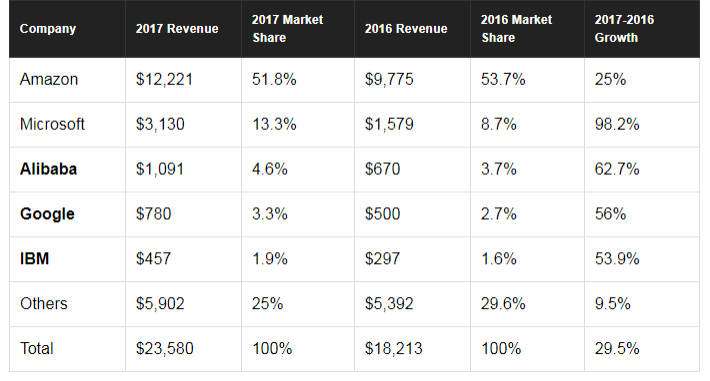Microsoft Is Taking On Amazon's Profit Center

Amazon (NASDAQ:AMZN) investors likely know the company's most visible business — e-commerce operations — isn't its most profitable. Instead, the company's smaller cloud business, Amazon Web Services (AWS), is its most profitable on account of higher margins. Last fiscal year, AWS produced 105 percent of Amazon's operating income as losses in international retailing offset North American retailing profit.
This article originally appeared in the Motley Fool.
Therefore, it's key for investors to pay close attention to Amazon's market position in cloud computing. Increasingly, the cloud has become a more-competitive industry, with second-largest provider Microsoft (NASDAQ:MSFT) starting to pick up market share. Do Amazon investors have anything to fear?
Gartner found Microsoft is gaining on Amazon
Per Gartner, the worldwide public infrastructure-as-a-service industry continues to post torrid growth rates, as spending increased 29.5 percent in 2017, growing from $18.2 billion to $23.5 billion. No surprise that Amazon continues to significantly lead this industry with a 51.8 percent market share. However, Amazon's lead over its peers continues to narrow, as the company lost 1.9 percentage points of share this year.

The biggest named gainer in Gartner's data was Microsoft and its Azure product. The company grew total market share from 8.7 percent in 2016 to 13.3 percent last year on the back of 98.2 percent growth. Overall, the cloud industry appears to be moving further toward a consolidation phase, as the top five vendors now claim 75 percent market share versus 70.5 percent in 2016.
These figures are for infrastructure as a service (IaaS), the base layer of the cloud stack. During the last conference call, CEO Satya Nadella noted the company's commercial cloud business exceeded $23 billion, but this comparison includes revenue attributable to Office 365, its cloud-based software-as-a-service product.
Two reasons for Azure's rapid growth
Azure's revenue growth has been greatly aided by large retailers with significant cloud-based spending: Walmart, Target, Costco, and Walgreens have all decided to use Microsoft's off-site servers, storage, and networking services. This has nothing to do with quality, but rather retailers have complained Amazon uses high-margin AWS to offset razor-thin margins from its e-commerce business. Former Walmart CEO Bill Simon went further, calling Amazon's strategy of using AWS to backstop low e-commerce profits "anti-competitive."
Additionally, Microsoft has done an admirable job building down the cloud stack with its platform-as-a-service (PaaS) and software-as-a-service (SaaS) offerings versus Amazon's IaaS-heavy approach. As noted earlier, the company has successfully transitioned its Office product to the cloud, with Office 365 revenue now eclipsing traditional Office licensing.
Growth rates can be deceiving
More recently, there's been an increase of headlines declaring that Microsoft is growing much faster than Amazon in the cloud. While this is certainly true, it's an incomplete picture due to the tremendous difference in growth rates. Revisiting the table above, Microsoft grew IaaS-attributable revenue 98 percent, which is admirable, but still only increased the figure by $1.6 billion.
Because Amazon continues to dominate this industry, it's difficult for the company to grow much more than the industry growth rate because of its disproportional pull on the total growth rate. Perhaps a better way is to look at this as a percentage of total growth. Amazon is still responsible for 45.6 percent of revenue growth in the cloud. Although the company would prefer to grow market share, it's clear it is still the biggest player in the market and not hemorrhaging market share.

Although Amazon should be less comfortable with its formidable position of a few years ago, Microsoft has been greatly aided by those large retailers, and it's likely IaaS-related revenue growth will slow in the upcoming years. Ultimately, however, cloud will not be a winner-take-all market, as the consolidating industry is expected to increase 58 percent over the next two years. In the end, investors in both companies should be encouraged by Gartner's report.
John Mackey, CEO of Whole Foods Market, an Amazon subsidiary, is a member of The Motley Fool's board of directors. Suzanne Frey, an executive at Alphabet, is a member of The Motley Fool's board of directors. Teresa Kersten is an employee of LinkedIn and is a member of The Motley Fool's board of directors. LinkedIn is owned by Microsoft. Jamal Carnette, CFA owns shares of Amazon and Target. The Motley Fool owns shares of and recommends Alphabet (A shares) and Amazon. The Motley Fool recommends Costco Wholesale and Gartner. The Motley Fool has a disclosure policy.





















